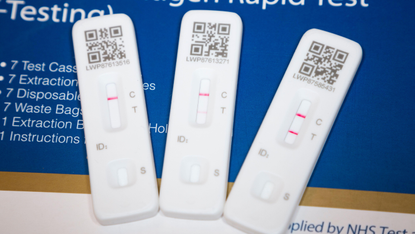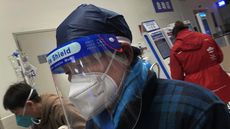What does a faint line mean on a Covid test?
Covid-19 infections were at their highest level of the year in March as official tracking ended

Routine asymptomatic testing across health and social care settings has come to an end this month and the official Covid survey has been axed.
The final Office for National Statistics (ONS) infection report was published last month just as Covid-19 cases in England “climbed to their highest level since the start of the year”, said The Independent.
An estimated 1.5m people in private households in England were likely to have had coronavirus in the week to 13 March, representing the highest total of Covid cases in England since the week to 3 January, when the total stood at around 2.2m, said Sky News.
Subscribe to The Week
Escape your echo chamber. Get the facts behind the news, plus analysis from multiple perspectives.

Sign up for The Week's Free Newsletters
From our morning news briefing to a weekly Good News Newsletter, get the best of The Week delivered directly to your inbox.
From our morning news briefing to a weekly Good News Newsletter, get the best of The Week delivered directly to your inbox.
Trends were less certain in Scotland, Wales and Northern Ireland due to a low number of samples received by the ONS. However, there were “signs the virus is continuing to spread” just as the three-year running infection survey – “dubbed ‘the envy of the world’ due to its success in tracking the virus” – was halted, said the broadcaster.
Nevertheless, with case numbers once again on the rise, many people still want to take a lateral flow test (LFT) before seeing loved ones, especially those who are elderly or vulnerable.
Should people still be taking lateral flows?
Most people are not required to take a test even if they show symptoms of Covid-19, but many still choose to and can buy lateral flow tests online or in pharmacies.
Routine asymptomatic testing for staff and patients in healthcare was mostly paused in August and came to an end on 1 April. However, lateral flow testing will continue in certain areas across the NHS, such as for staff showing symptoms if they work with severely immunosuppressed patients and for all patients being discharged from hospitals into care settings.
LFTs have become part of everyday life for people across the UK as an easy and quick way to detect Covid-19 infections. But as they have become “the first point of call for many concerned Brits”, said the Daily Express, “confusing results” have become “more common” too, owing to variation in the clarity of the lines appearing in the results window.
What does a faint line mean?
After a nasal swab sample is applied to the test, a red line will appear next to the letter “C”, for “control”, if the device is working properly. If the test identifies the presence of the Covid-19 virus in the sample, a second line should appear next to the “T” within the next 15 to 30 minutes.
Although some positive tests show a clear red line next to the “T”, others may be fainter or wobblier. But “if you can see any line at all, you are still highly likely to be infectious”, said science journalist and author Linda Geddes in an article for Gavi, the Vaccine Alliance.
A “faint, slow-to-appear line could still represent high levels of virus”, she said. The intensity of the test line could be “influenced by how much virus you were able to collect on your swab, and where you collected it from (nose or throat), while mutations in Covid variants may further impact test sensitivity and line intensity”.
What are the latest rules for testing?
Free testing for coronavirus has now ended for most people in England and nobody is required by law to self-isolate. If you have symptoms of Covid-19 or have tested positive, the government advises that you “should try to stay at home”.
The NHS suggests this should be for three days after a positive test for under-18s and five days for adults. The health service advises people with Covid to avoid meeting anyone who could become seriously ill from the disease for at least ten days after the initial positive test.
Why is the infection survey ending?
In line with the “changing path” of the coronavirus pandemic, the UK Health Security Agency (UKHSA) is reviewing its “approach to Covid-19 surveillance”, says a message on the ONS site.
Oxford University virologist Professor Aris Katzourakis called the decision “incomprehensible” and warned that the UK could be “fighting blind” against Covid in the absence of regular updates.
“It’s been a model for the world to emulate. The ONS survey has been so useful in knowing exactly what’s happening, how concerned to be, and whether a policy response is required,” he told The Independent.
But Professor Azeem Majeed, head of the Department of Primary Care & Public Health at Imperial College London, told the paper that its cost was taking away funds from other public sector needs.
“We don’t measure other infections like tuberculosis and flu, so what the government is saying is treat Covid like other infections,” said Majeed. “The NHS is under a lot of pressure, and so is public spending, so money spent on the survey could be spent elsewhere.”
He added that he was not “massively concerned” so long as there were other measures in place to track Covid in a similar way as other infections are tracked.
Any further monitoring of the virus is due to be announced after the review to ensure it is “cost effective”.
Create an account with the same email registered to your subscription to unlock access.
Sign up for Today's Best Articles in your inbox
A free daily email with the biggest news stories of the day – and the best features from TheWeek.com
-
 'Horror stories of women having to carry nonviable fetuses'
'Horror stories of women having to carry nonviable fetuses'Instant Opinion Opinion, comment and editorials of the day
By Harold Maass, The Week US Published
-
 Haiti interim council, prime minister sworn in
Haiti interim council, prime minister sworn inSpeed Read Prime Minister Ariel Henry resigns amid surging gang violence
By Peter Weber, The Week US Published
-
 Today's political cartoons - April 26, 2024
Today's political cartoons - April 26, 2024Cartoons Friday's cartoons - teleprompter troubles, presidential immunity, and more
By The Week US Published
-
 Covid four years on: have we got over the pandemic?
Covid four years on: have we got over the pandemic?Today's Big Question Brits suffering from both lockdown nostalgia and collective trauma that refuses to go away
By Chas Newkey-Burden, The Week UK Published
-
 The hollow classroom
The hollow classroomOpinion Remote school let kids down. It will take much more than extra tutoring for kids to recover.
By Mark Gimein Published
-
 Excess screen time is making children only see what is in front of them
Excess screen time is making children only see what is in front of themUnder the radar The future is looking blurry. And very nearsighted.
By Devika Rao, The Week US Published
-
 Covid-19: what to know about UK's new Juno and Pirola variants
Covid-19: what to know about UK's new Juno and Pirola variantsin depth Rapidly spreading new JN.1 strain is 'yet another reminder that the pandemic is far from over'
By Arion McNicoll, The Week UK Published
-
 Long-term respiratory illness is here to stay
Long-term respiratory illness is here to stayThe Explainer Covid is not the only disease with a long version
By Devika Rao, The Week US Published
-
 Covid inquiry: the most important questions for Boris Johnson
Covid inquiry: the most important questions for Boris JohnsonTalking Point Former PM has faced weeks of heavy criticism from former colleagues at the public hearing
By The Week Staff Published
-
 China's pneumonia cases: should we be worried?
China's pneumonia cases: should we be worried?The Explainer Experts warn against pushing 'pandemic panic button' following outbreak of respiratory illness
By Keumars Afifi-Sabet, The Week UK Published
-
 Vallance diaries: Boris Johnson 'bamboozled' by Covid science
Vallance diaries: Boris Johnson 'bamboozled' by Covid scienceSpeed Read Then PM struggled to get his head around key terms and stats, chief scientific advisor claims
By The Week UK Published